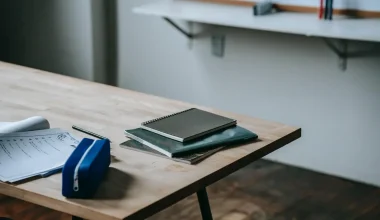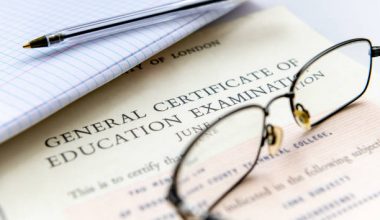Even though computers and other technology are becoming more and more significant teaching aids, many UK students still take exams on paper. This is especially true for common essay subjects like history and English, which might need a significant length of writing.
Writing for more than an hour straight is a challenging endeavor for any individual. You might be wondering if hiring a scribe—someone to record your answers as you speak—is an option for your exam.
According to studies by National Center for Education Statistics, approximately 6.7 million students in the United States alone receive special education services, highlighting the importance of accommodating diverse learning needs.
In this article, we’ll discuss the concept of having a scribe for exams, We will also explain common concerns to help you better understand how this accommodation can make a difference in your educational journey.
Table of contents
- Who is a Scribe for Exams?
- Who is Eligible for a Scribe?
- How Does The Scribe Arrangement Work?
- Are There Any Limitations to Using a Scribe?
- How Do You Request a Scribe for Exams?
- How Do You Prepare for Taking an Exam With a Scribe?
- Is There a Difference Between a Scribe and a Reader for Exams?
- Do Colleges and Universities Provide Scribes for Standardized Tests?
- How Can Scribe Accommodations Benefit Students?
- FAQs
- Conclusion
- References
- Recommendations
Who is a Scribe for Exams?
A scribe for exams is a designated person who assists students during their examinations by transcribing their spoken responses onto the exam paper.
This accommodation is particularly helpful for students facing challenges in writing due to diverse reasons such as physical disabilities, learning disorders, or medical conditions.
When students encounter difficulty in physically writing their answers, a scribe becomes an indispensable aid.
Sometimes these students do not know how to write fast in exams, hence, the need for a scribe.
As the student verbalizes their answers, the scribe meticulously records them, ensuring accurate representation. This assistance takes the burden off students who might struggle with the physical act of writing, enabling them to concentrate on expressing their knowledge.
However, it is important to note that the scribe’s role is limited to transcribing and does not encompass any interpretation or modification of the content. This straightforward process can significantly enhance the exam experience for students who require this accommodation.
In essence, a scribe bridges the gap between a student’s thoughts and the written exam, enabling equitable assessment.
See also: When Do A-Levels Start And Finish in 2024?
Who is Eligible for a Scribe?
The eligibility criteria for having a scribe for exams vary based on the guidelines set by educational institutions. Generally, students with documented disabilities impacting their writing ability can request this accommodation. For instance, physical impairments, visual limitations, or conditions like dysgraphia are common qualifiers.
Moving to the specifics, students experiencing difficulty writing legibly or within the designated time frame because of their disability are prime candidates.
However, educational institutions require students to provide documented evidence of their disability when applying for a scribe. This evidence substantiates the need for the accommodation, ensuring fairness.
Furthermore, students must liaise with their institution’s disability services office, which oversees the accommodation process. This straightforward procedure ensures that students who genuinely require a scribe receive the support they need.
In essence, eligibility is granted to students with demonstrated disabilities affecting their writing abilities. By adhering to these guidelines, educational institutions ensure that students facing writing challenges can confidently request and receive the assistance they need to excel during exams.
See also: How to Receive Extra Time For GCSE, A-Level, and University Exams
How Does The Scribe Arrangement Work?
The scribe arrangement involves a designated individual who assists students during exams by transcribing their verbalized answers onto the exam paper. This process is orchestrated seamlessly, ensuring an accurate representation of the student’s responses.
To start, when a student dictates their answers, the scribe records them meticulously, maintaining fidelity to the student’s original words. Talking about the logistics, this arrangement allows students who face challenges in physically writing to focus solely on conveying their knowledge.
By employing a scribe, educational institutions cater to students with distinct needs, ensuring that they can effectively demonstrate their knowledge without being impeded by writing difficulties.
See also: 17 Best Online English Literature Tutoring Services in 2024
Are There Any Limitations to Using a Scribe?
Using a scribe for exams offers valuable assistance to students with writing difficulties, yet it’s crucial to be aware of its limitations.
One key point to note is that a scribe solely transcribes the student’s dictated answers, refraining from adding any input. Hence, this means that the scribe doesn’t contribute to the content or offer explanations related to the questions.
Additionally, it’s essential to understand that the scribe accommodation doesn’t alter the exam’s content or format. The questions and tasks remain consistent for all students, ensuring fairness. The accommodation focuses solely on overcoming writing-related obstacles. The scribe does not aid in comprehending complex instructions or clarifying queries, emphasizing the need for thorough preparation.
Furthermore, while the scribe enables students to express their knowledge without the hindrance of writing difficulties, it doesn’t provide an advantage in terms of content mastery.
It’s also important to consider that using a scribe doesn’t guarantee a certain exam outcome; rather, it helps students accurately convey what they know.
Lastly, acknowledging these limitations while appreciating the accommodation’s benefits allows students to make the most of their exam experience. By understanding both its capabilities and boundaries, students can ensure they are well-prepared and equipped for success.
See also: How Should the First Meeting of Student and Tutor Go?
How Do You Request a Scribe for Exams?
Requesting a scribe for exams involves a structured process that varies among educational institutions.
To initiate this process, students should first approach their institution’s disability services office. This office specializes in facilitating accommodations for students with diverse needs. Moving forward, students need to provide documented evidence of their disability that substantiates their need for a scribe.
Typically, this documentation includes medical records or assessments that highlight the impact of the disability on the student’s writing ability. After submitting the necessary documentation, students will likely engage in a discussion with a designated coordinator. This conversation helps determine the student’s specific requirements and how the accommodation can be best implemented.
Once the approval for a scribe is granted, the educational institution takes on the responsibility of arranging for a trained scribe to be present during the exam.
It’s important to note that the process demands proactive engagement from the student. Communicating clearly with the disability services office and adhering to any deadlines or procedures is essential for a smooth arrangement. By following these steps, students can ensure that their request for a scribe is processed effectively, enabling them to perform at their best during exams.
See also: How to Find a Tutor for Your Child in 2024 | Top 7 Ways
How Do You Prepare for Taking an Exam With a Scribe?
Preparing for an exam with a scribe requires careful planning and effective communication.
Firstly, it’s crucial to practice dictating your answers coherently. This helps you become accustomed to articulating your thoughts clearly, facilitating a smoother process on exam day. Also, arranging your notes and thoughts in a structured manner can aid the scribe in accurately transcribing your responses.
Furthermore, discussing your needs and preferences with the scribe can foster a comfortable working dynamic. Communicate your desired pace and any specific instructions, ensuring mutual understanding.
On the practical side, arriving early on exam day enables you to familiarize the scribe with your speaking style and any terminology specific to the subject. This step prevents misunderstandings during the actual exam.
During the test, remember that the scribe is solely responsible for transcription. Focus on expressing your knowledge while adhering to time constraints. Utilize the scribe accommodation as a tool to showcase your abilities without the impediment of writing difficulties.
In essence, thorough preparation, clear communication, and a collaborative approach ensure that you can make the most of the scribe accommodation and perform at your best during exams.
See also: The Night Before a GCSE Exam: A Survival Guide in 2024
Is There a Difference Between a Scribe and a Reader for Exams?
Indeed, there is a notable distinction between a scribe and a reader in the context of exam accommodations. A scribe assists by transcribing verbalized answers onto the exam paper, aiding students with writing difficulties. However, a reader assists by reading aloud exam questions and written content, primarily catering to students who struggle with reading due to various reasons.
To illustrate the difference, while a scribe focuses on the act of writing, a reader’s support lies in comprehension. A reader’s vocalization of the questions ensures that students with reading challenges can access the content effectively.
In comparison, the scribe captures the student’s spoken answers, allowing them to convey their understanding without the hindrance of writing limitations.
Furthermore, it’s important to acknowledge that both roles play distinct yet equally valuable parts in leveling the playing field for students with diverse needs. Scribes enable students to express their knowledge accurately, while readers facilitate understanding by providing auditory access to exam content.
Understanding these differences empowers students to choose the accommodation that best addresses their specific challenges, ultimately leading to a fair and inclusive exam experience.
See also: How Many Times Should I Take the ACT or SAT? 2024 Tips
Do Colleges and Universities Provide Scribes for Standardized Tests?
When it comes to standardized tests, such as the SAT or ACT, colleges and universities do recognize the importance of providing accommodations like scribes.
These institutions generally have dedicated disability services to cater to diverse needs, ensuring an equitable testing environment. However, the process for obtaining accommodations for standardized tests slightly differs from regular exams.
Students seeking accommodations for standardized tests must navigate a distinct application process managed by the respective testing agencies. These agencies, such as the College Board for the SAT, have their guidelines and requirements for requesting accommodations. Students need to research and familiarize themselves with the specific procedures laid out by these agencies.
Furthermore, documentation of the student’s disability and its impact on their exam-taking abilities is typically a mandatory component of the application. Once approved, the testing agency collaborates with the student and their institution to ensure that the appropriate accommodation, such as a scribe, is provided during the standardized test.
In essence, while colleges and universities strive to provide a supportive environment for students with disabilities, the process for securing scribe accommodations for standardized tests involves adherence to the specific guidelines of the relevant testing agencies.
By proactively engaging in the application process, students can ensure that they receive the necessary accommodations to perform at their best on these standardized exams.
See also: Exams Don’t Define You – How to Stand Beyond Exam Setbacks
How Can Scribe Accommodations Benefit Students?
Scribe accommodations hold significant benefits for students facing writing-related challenges. These accommodations, by enabling students to express their thoughts verbally, bridge the gap between their knowledge and their ability to write.
This, in turn, allows them to fully showcase their understanding of the subject matter. Moving forward, these accommodations provide a level playing field for students who, due to physical disabilities or learning disorders, encounter difficulties in writing.
Additionally, scribe accommodations reduce the impact of writing limitations on exam performance. Students can concentrate on articulating their ideas without the hindrance of struggling to put them on paper.
Moreover, these accommodations emphasize the importance of assessing students based on their comprehension and knowledge, rather than their writing speed or legibility.
Furthermore, scribe accommodations empower students to demonstrate their true capabilities. By removing the barrier of writing challenges, students can perform to the best of their abilities, leading to more accurate and fair assessment outcomes. Ultimately, these accommodations nurture inclusivity and support diversity within educational environments.
In essence, scribe accommodations serve as a tool that levels the playing field, allowing students to articulate their knowledge without being limited by writing difficulties.
By embracing these accommodations, educational institutions pave the way for students to excel based on their understanding and aptitude, fostering an environment of equal opportunity and fairness.
See also: GCSE Mark Schemes and Examiner Reports Explained in 2024
FAQs
A Scribe is a person who writes down a candidate’s dictated answers to questions in an examination. The scribe must record only the dictated words. It is not the role of the scribe to structure, punctuate or plan answers for the student.
You may need a Scribe and/or Reader for a variety of reasons. You may have a temporary or ongoing disability such as a mobility impairment or dyslexia. A Scribe is a person who writes or types for a candidate who is either unable to write or is significantly restricted in their ability to write due to a disability.
A scribe (sometimes referred to as an ‘Amanuensis’) is a person who writes or word processes a student’s dictated answers in exams. Scribes need to be familiar with the subject area and terminology and to have neat and legible handwriting, or, if using a computer, they should be proficient in word processing.
This might suggest that notes were made by or for women. This is just a sample of some of the earlier manuscripts in the British Library’s collection which have been associated with female scribes. Later periods provide even more examples of female scribes, from the author Christine de Pizan to Elizabeth I.
A scribe is a certified adult who writes down what a student dictates in a variety of ways (e.g., speech, American Sign Language (ASL), braille, an assistive communication device, etc.). The guiding principle in scribing is to ensure that the student has access to and is able to respond to test content.
Conclusion
Having a scribe for exams can be a game-changer for students with writing-related disabilities. This accommodation aims to ensure that these students can demonstrate their knowledge and skills on a level playing field.
By understanding the process, eligibility criteria, and benefits of scribe accommodations, students can take proactive steps to make their educational journey more accessible and inclusive.
References
- Melbournechildpsychology.com – Preparing To Use A Scribe For Exams
- Uhi.ac.uk – Using a scribe in examinations
Recommendations
- 10 Scholarships For Autistic Students In 2024 | Apply Now
- Homeschooling requirements UK 2024: All you need to know
- Last-Minute GCSE Revision Tips| Score Higher In Last Minute
- Great Tips to Study the Subjects You Absolutely Hate in 2024
- How to pull an all-nighter for school | 10 Best Tips
- How to Study For a Real Estate Exam in 2024 | Full Guide






